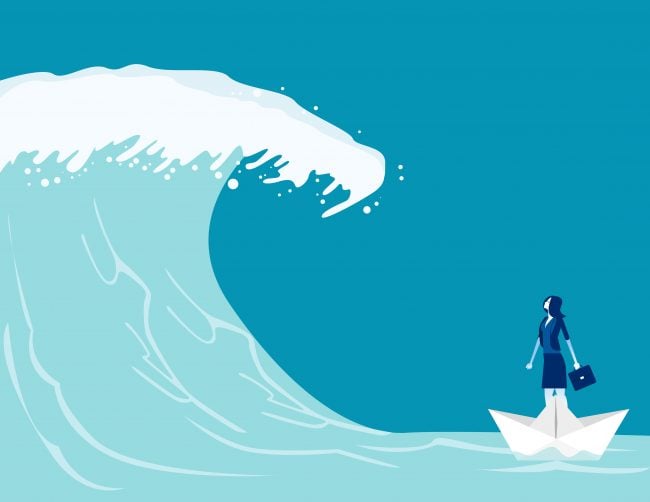 Source: Adobe Stock
Source: Adobe Stock
From December tornadoes to record-breaking heat, our attention seems to be captured by extreme weather. Of all the hazardous weather events, major tsunamis are thankfully among the most infrequent. But when they do occur, they can have a dramatic, catastrophic impact, as we've seen in recent images from the South Pacific, where an underwater volcanic eruption triggered a tsunami so powerful its effects could be felt thousands of miles away.
As with violent forces of nature, the effects of sudden change in financial consumer behaviors can be devastating if senior executives are not focused on the right indicators – or not prepared to deal with the outcomes. What today's leaders need is an early warning system that elevates financial institutions over banking industry tsunamis.
Recommended For You
There is such a system: A comprehensive, five-step process that can pinpoint potential and developing CX challenges, then preemptively inform with intelligent action to intercept them. Leveraging leading indicators rather than lagging indicators prepares you to not just withstand the effects of the next major industry disruption, but to identify its root cause(s) … before it happens! What better way to make it through the next catastrophic event than to avoid it in the first place?
Shock Events: Natural and Financial
The four stages of the tsunami lifecycle parallel a credit union's potential CX disaster following a shock event:
Initiation
- Natural tsunami: A large and sudden undersea disturbance, most frequently an earthquake, generates a series of long ocean waves.
- CU tsunami: A shock event like a core conversion, merger, or the introduction of a new banking channel generates a rise in dissatisfaction, friction and ultimately member attrition.
Split
- Natural tsunami: The initial series of waves divides, with one group radiating out into the deep ocean and another travelling toward nearby land.
- CU tsunami: Some areas of your organization will be impacted more directly or severely than others by the shock event. The front lines, for example, will bear the brunt of your members' initial reaction. You must allocate resources to counter the effects. But you need sound intel to get to the root of the problem and determine where your efforts will have the most beneficial results.
Amplification
- Natural tsunami: Wave height increases, along with the distance between wave crests as they travel toward land. The leading wave becomes steep.
- CU tsunami: With fluctuations in consumer tolerance, a little problem can quickly grow into a major issue. As consumers migrate to digital, your online banking and mobile app need to provide an experience consistent with your other delivery channels. One bad experience – e.g., being stuck on hold indefinitely with the call center – can be shared with many other consumers very quickly through social media, triggering a disproportionate impact on your reputation.
Run-up:
- Natural tsunami: A peak of the tsunami hits, inundating the shore above sea level. A larger tsunami may come onshore like a fast-rising flood or a wall of turbulent water; it can flood low-lying coastal areas more than a mile inland.
- CU tsunami: The effects of the triggering event – member attrition, employee turnover – are felt throughout your organization, to a degree and duration determined by your foresight, preparation and resilience. Your frontline employees may be overwhelmed without proper resources and supporting infrastructure.
It can be difficult to predict when and where a threat will arise. There is often little surface evidence early on, so it takes specialized, sensitive equipment to detect the little rumbles that may precede a large-scale disaster.
Credit union executives are bracing for the business challenges sure to come. As with an undersea disturbance, unseen friction in the member experience grows exponentially – with potentially devastating results! Because of uncertainty about what form the next threat will take, an agile, responsive early warning system based on leading indicators is the best way to be prepared.
Leading Versus Lagging Indicators
Though some financial institutions are resting on lagging financial indicators, in reality leading indicators are the best way to mitigate the impact of that next shock event on your balance sheet. It's the "ounce of prevention" approach! Metrics like strong core earnings, net income and capital growth will not be affected early on. Relying on them can create a false sense that things are going smoothly. By the time the disruptive waves are reflected in the balance sheet, the tsunami has made landfall. At that point, bailing out and restoring what has been lost is a daunting task – it can be done, but it could have been avoided.
The value of leading indicators is that they enable you to take informed action to intercept the future. The most valuable leading indicators are those that show in real time what's happening when members encounter systemic friction or troubling hotspots, whether in the digital user experience, in-branch interaction or call center communication. This in-the-moment reality dictates whether your members stay with you – or not. It also determines how they speak about you on social media.
Are you tracking these leading indicators/early warning signs?
- Increase in volume and range of member complaints, especially about a certain product, channel, etc.
- Escalation of member complaints to higher level executives.
- Proliferation of "one-off" bad experiences into systemic CX issues.
- Influx of call center activity because the member couldn't complete the transaction in the channel where it began
Ultimately such instances have visible impact, through lagging indicators of members minimizing their business with you or even closing their accounts. This situation is not hopeless, but recovery will require quick, pinpointed and deep analysis to focus in the right direction: Your member relationships. Sustaining these relationships will ensure that the financials remain strong. So when the next wave hits, it won't wash away the present leadership.
Here's How to Do It: A 5-Step, Proven Model for CX Success

1. Diagnose: Start with a clear picture of where you are today. Use comprehensive measurement to uncover CX friction preventing you from living up to your brand standard or to your members' changing expectations.
2. Prioritize: With pinpoint precision, identify your CX "hot spots" throughout all products, processes, people and channels, so executives can determine exact areas of focus in alignment with business objectives.
3. Fix: Identify key themes and insights emerging from the CX data, and adopt specific steps toward remedying "hot spots" and/or systemic issues at the root level.
4. Accelerate: Use ongoing executive-level insight to inform your CX strategy and drive its execution, shortening the time to action.
5. Differentiate: This is where you want to be! Backed by key performance metrics, build a visible culture of service quality that grows member loyalty and sets you apart.
Like the stages of a tsunami, each step builds on the previous, until you regain your losses and surge toward differentiation!
Building a Disaster-Proof Strategy
The next tsunami in the banking industry is a matter of "when," not "if." The five-step model described above can help you not just survive the event, but thrive based on your ability to manage it.
This model is a blueprint for purposeful/intentional change, driving your organization toward your key objectives, like increased member loyalty and sustained revenue growth. It increases responsiveness to pressing problems and gets you in front of potential issues more than reliance on lagging indicators ever could. It builds a floodwall against a rush of negative CX drivers – not just the initial swell, but successive waves as well.
This is a plan focused on practical results. It recognizes and responds to the shorter time you have to strategize and act now, in a market where consumers are increasingly intolerant and impatient. Most importantly, it equips you to anticipate change and get ahead of it, so that what may be a shock event for others is another opportunity for you to prove your ongoing value to your members.
 Rhonda Sheets
Rhonda Sheets Rhonda Sheets is the Founder, President and CEO of CX analytics company Support EXP in Centerville, Ohio.
© Touchpoint Markets, All Rights Reserved. Request academic re-use from www.copyright.com. All other uses, submit a request to [email protected]. For more inforrmation visit Asset & Logo Licensing.






